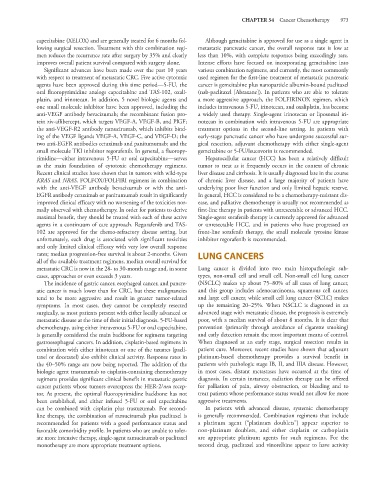Page 987 - Basic _ Clinical Pharmacology ( PDFDrive )
P. 987
CHAPTER 54 Cancer Chemotherapy 973
capecitabine (XELOX) and are generally treated for 6 months fol- Although gemcitabine is approved for use as a single agent in
lowing surgical resection. Treatment with this combination regi- metastatic pancreatic cancer, the overall response rate is low at
men reduces the recurrence rate after surgery by 35% and clearly less than 10%, with complete responses being exceedingly rare.
improves overall patient survival compared with surgery alone. Intense efforts have focused on incorporating gemcitabine into
Significant advances have been made over the past 10 years various combination regimens, and currently, the most commonly
with respect to treatment of metastatic CRC. Five active cytotoxic used regimen for the first-line treatment of metastatic pancreatic
agents have been approved during this time period—5-FU, the cancer is gemcitabine plus nanoparticle albumin-bound paclitaxel
oral fluoropyrimidine analogs capecitabine and TAS-102, oxali- (nab-paclitaxel [Abraxane]). In patients who are able to tolerate
platin, and irinotecan. In addition, 5 novel biologic agents and a more aggressive approach, the FOLFIRINOX regimen, which
one small molecule inhibitor have been approved, including the includes intravenous 5-FU, irinotecan, and oxaliplatin, has become
anti-VEGF antibody bevacizumab; the recombinant fusion pro- a widely used therapy. Single-agent irinotecan or liposomal iri-
tein ziv-aflibercept, which targets VEGF-A, VEGF-B, and PlGF; notecan in combination with intravenous 5-FU are appropriate
the anti-VEGF-R2 antibody ramucirumab, which inhibits bind- treatment options in the second-line setting. In patients with
ing of the VEGF ligands VEGF-A, VEGF-C, and VEGF-D; the early-stage pancreatic cancer who have undergone successful sur-
two anti-EGFR antibodies cetuximab and panitumumab; and the gical resection, adjuvant chemotherapy with either single-agent
small molecule TKI inhibitor regorafenib. In general, a fluoropy- gemcitabine or 5-FU/leucovorin is recommended.
rimidine—either intravenous 5-FU or oral capecitabine—serves Hepatocellular cancer (HCC) has been a relatively difficult
as the main foundation of cytotoxic chemotherapy regimens. tumor to treat as it frequently occurs in the context of chronic
Recent clinical studies have shown that in tumors with wild-type liver disease and cirrhosis. It is usually diagnosed late in the course
KRAS and NRAS, FOLFOX/FOLFIRI regimens in combination of chronic liver disease, and a large majority of patients have
with the anti-VEGF antibody bevacizumab or with the anti- underlying poor liver function and only limited hepatic reserve.
EGFR antibody cetuximab or panitumumab result in significantly In general, HCC is considered to be a chemotherapy-resistant dis-
improved clinical efficacy with no worsening of the toxicities nor- ease, and palliative chemotherapy is usually not recommended as
mally observed with chemotherapy. In order for patients to derive first-line therapy in patients with unresectable or advanced HCC.
maximal benefit, they should be treated with each of these active Single-agent sorafenib therapy is currently approved for advanced
agents in a continuum of care approach. Regorafenib and TAS- or unresectable HCC, and in patients who have progressed on
102 are approved for the chemo-refractory disease setting, but front-line sorafenib therapy, the small molecule tyrosine kinase
unfortunately, each drug is associated with significant toxicities inhibitor regorafenib is recommended.
and only limited clinical efficacy with very low overall response
rates; median progression-free survival is about 2-months. Given LUNG CANCERS
all of the available treatment regimens, median overall survival for
metastatic CRC is now in the 28- to 30-month range and, in some Lung cancer is divided into two main histopathologic sub-
cases, approaches or even exceeds 3 years. types, non-small cell and small cell. Non-small cell lung cancer
The incidence of gastric cancer, esophageal cancer, and pancre- (NSCLC) makes up about 75–80% of all cases of lung cancer,
atic cancer is much lower than for CRC, but these malignancies and this group includes adenocarcinoma, squamous cell cancer,
tend to be more aggressive and result in greater tumor-related and large cell cancer, while small cell lung cancer (SCLC) makes
symptoms. In most cases, they cannot be completely resected up the remaining 20–25%. When NSCLC is diagnosed in an
surgically, as most patients present with either locally advanced or advanced stage with metastatic disease, the prognosis is extremely
metastatic disease at the time of their initial diagnosis. 5-FU-based poor, with a median survival of about 8 months. It is clear that
chemotherapy, using either intravenous 5-FU or oral capecitabine, prevention (primarily through avoidance of cigarette smoking)
is generally considered the main backbone for regimens targeting and early detection remain the most important means of control.
gastroesophageal cancers. In addition, cisplatin-based regimens in When diagnosed at an early stage, surgical resection results in
combination with either irinotecan or one of the taxanes (pacli- patient cure. Moreover, recent studies have shown that adjuvant
taxel or docetaxel) also exhibit clinical activity. Response rates in platinum-based chemotherapy provides a survival benefit in
the 40–50% range are now being reported. The addition of the patients with pathologic stage IB, II, and IIIA disease. However,
biologic agent trastuzumab to cisplatin-containing chemotherapy in most cases, distant metastases have occurred at the time of
regimens provides significant clinical benefit in metastatic gastric diagnosis. In certain instances, radiation therapy can be offered
cancer patients whose tumors overexpress the HER-2/neu recep- for palliation of pain, airway obstruction, or bleeding and to
tor. At present, the optimal fluoropyrimidine backbone has not treat patients whose performance status would not allow for more
been established, and either infused 5-FU or oral capecitabine aggressive treatments.
can be combined with cisplatin plus trastuzumab. For second- In patients with advanced disease, systemic chemotherapy
line therapy, the combination of ramucirumab plus paclitaxel is is generally recommended. Combination regimens that include
recommended for patients with a good performance status and a platinum agent (“platinum doublets”) appear superior to
favorable comorbidity profile. In patients who are unable to toler- non-platinum doublets, and either cisplatin or carboplatin
ate more intensive therapy, single-agent ramucirumab or paclitaxel are appropriate platinum agents for such regimens. For the
monotherapy are more appropriate treatment options. second drug, paclitaxel and vinorelbine appear to have activity

